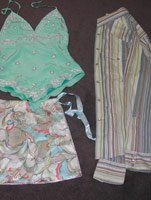Finding Their Niche: Companies Look to Break Into the Surf Market
Surf’s up. A trio of small surfwear companies is chasing waves leading to big sales in the growing surfwear market.
One of them is Surf Line Hawaii Ltd., which had its heyday in the mid-’80s with its colorful Jams shorts. Then there are Veltex Corp. and Aqua VI, which both will launch new lines in 2005 on opposite ends of the pricing spectrum. Whereas Veltex makes private-label goods for surf companies, Aqua VI boasts industry veterans Lian Murray and Ziggy Williams as designers and Lucky Brand Jeans’ Barry Perlman as an angel investor.
The companies’ timing seems right. Board-Trac, a market research company in Trabuco Canyon, Calif., estimated that domestic surf sales totaled $4.14 billion in 2003, the latest year for which it had compiled figures. That’s a 24 percent increase from sales of $3.33 billion in 2002. The San Clemente, Calif.–based Surf Industry Manufacturers Association said the worldwide market is now valued at more than $6 billion. Quiksilver Inc. of Huntington Beach, Calif., alone totaled $1.27 billion in global sales in the fiscal year ended Oct. 31.
These statistics reveal both opportunities and challenges facing new companies. Emerging labels can try to ride surfwear’s popularity. But they also must escape the shadow cast by Billabong, Hurley International and other behemoths. Board-Trac Managing Director Marie Case said youths under 20 form the bulk of the market and stick with brands they already wear as they get older. Case said young companies can find success with the right price points, distribution channels, branding and styling.
Grabbing space in stores can be tough, however. “The only way I can bring more lines in is [to] hang them from the ceiling,” said Chris Saenz, general manager for Huntington Surf and Sport in Huntington Beach. He said it is difficult to walk away from established players offering “spot-on” marketing and designs and reliable deliveries.
What Surf Line, Veltex and Aqua VI have in common is an early focus on female consumers. Case said that although women make up merely one-third of surfers, they spend $5 more per T-shirt than men do.
Surf Line President Pua Rochlen agreed that girls are “the real consumers.” Surf Line, which is based in Honolulu and has a store in Santa Monica, Calif., saw its wholesale volume and workforce shrink to $9.5 million and 121 employees from its peak of $30 million and 150 employees in the ’80s. Wholesale prices range from $9 for T-shirts to $28 for nylon capris. But Rochlen, who was 2 when his parents started the company in 1964, is trying to stage a comeback. He plans to double or triple the Surf Line sales force, currently at two employees, and promote Surf Line’s retro ’60s prints, available in loose capris, dresses and other items made mostly of nylon. Rochlen is considering launching a third label featuring new fabrics and new silhouettes in February. “Our colors stand out,” he said, adding that he is targeting “the teenagers that want something other than Quiksilver, Roxy or Hurley.”
Javeed Matin, chief executive of Veltex in City of Industry, Calif., said his strategy is to introduce clothing, sandals, surfboards and accessories that are priced lower than what is on the market. He said he is budgeting $25 million to acquire a surfwear company and more than $100,000 to promote a new line called Velvet. For Spring 2005, Velvet will wholesale $8 T-shirts and $30 jeans and corduroy pants. Matin projects Velvet’s wholesale volume in the first year will reach $10 million, or a quarter of Veltex’s total revenue.
Murray said Aqua VI is different from other surf lines because it uses more expensive fabrics and embellishments such as embroidery and batik. The Summer 2005 line, wholesaling from $15 to $75, will include boardshorts with detailed metal draw-cord tips and Italian denim jeans. Also in the works is a swimwear collection. Murray said she doesn’t have dates, prices or a contract for the swim line yet but she has already found inspiration in “uncharted waters [and] old Italian maritime maps.”
Perlman, the Lucky co-founder who is an angel investor, declined to comment on his involvement.
Aqua VI will publish its first ad in the January issue of a premium magazine called Risen. “It sums up what we want to be in,” Williams said.
























